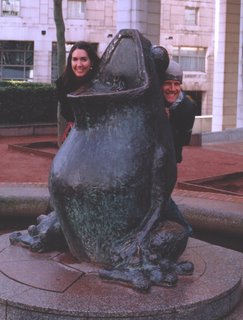Happy (belated) Darwin Day!
I hope you all had a nice Darwin Day on last Thursday (2/12) celebrating the bicentennial of Darwin's birth. (And Abraham Lincoln's, too. What an odd coincidence.) I made cupcakes for my history of science class and we watched part of a NOVA video on Evolution that includes some entertaining re-enactments of Darwin's life, including Darwin wooing his cousin (ew!) Emma Wedgwood. Hopefully they'll remember the cupcakes when I make them read On the Origin of Species later in the semester.
Anne and I also went to a Darwin party that night at our friends Erin and Lindsey's house, where we feasted on finch wings (ok, they were chicken) and a tortoise-shaped cake and drank Captain Fitzroy's rum and Cokes. They probably didn't have Coke on the Beagle, but no need to deprive ourselves. We had a couple rounds of Darwin trivia and even played a rousing game of Pin the Beak on the Finch. I did ok with the trivia, but not so well with the beak game. Maybe next year....

